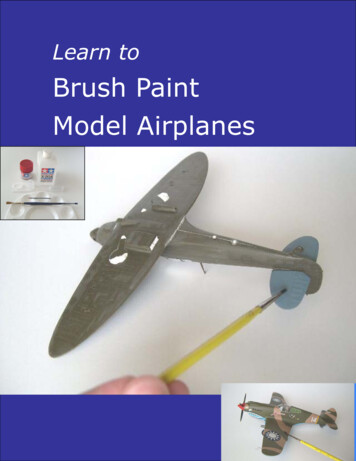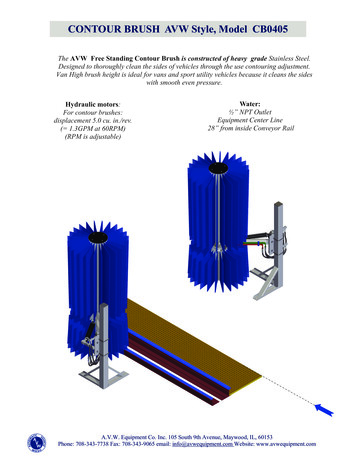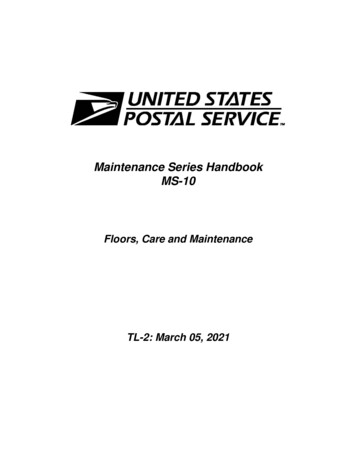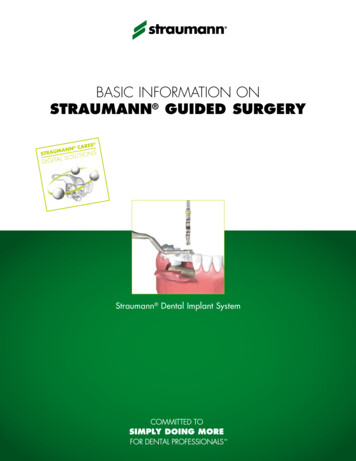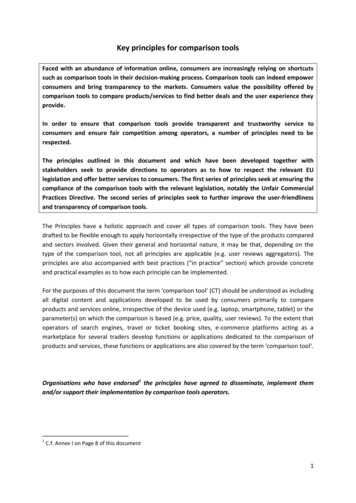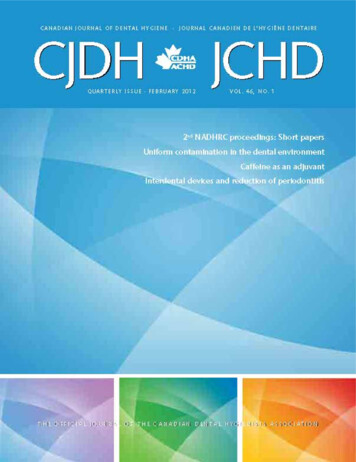
Transcription
Interdentalof periodontitise v deviceside nandce reductionfor practiceComparison of interdental brush to dental floss forreduction of clinical parameters of periodontal disease:A systematic reviewPauline H. Imai , DipDH, BDSc(DH), MSc(Dent Sc), RDH; Xiaoli Yu*, MSc; David MacDonald§, BDS, BSc(Hons.), LLB(Hons.), MSc, DDS(Edin.), DDRRCR,FDSRCPS, FRCD(C).AbstractBackground: Daily oral biofilm disruption by clients isrecommended by oral health professionals to prevent oraldiseases and to maintain optimal oral and overall health. Sinceperiodontal diseases and caries are prevalent interproximally,the adjunctive use of interdental aids is highly recommended.Objectives: To evaluate the effectiveness of interdental brushingas an adjunct to toothbrushing for the primary outcome ofinterproximal gingival bleeding and a secondary outcome ofinterproximal plaque. Methods: Only randomized controlledtrials were included. Studies were included irrespectiveof publication status and language. Hand searching wasconducted in two peer reviewed journals, with references mined.Pharmaceutical companies that develop and manufactureinterdental brushes were also contacted for unpublishedor ongoing clinical trials. Sixty-two studies were retrievedfrom the literature with seven studies meeting the inclusion/exclusion criteria. Forest plots and Chi-square tests were usedto determine the presence of heterogeneity. Random effectsmodel, relative risk and 95% confidence intervals were used inthe analysis. Results: Four studies were included in the metaanalysis for bleeding outcome. Although some heterogeneitywas present among the studies, the interdental brush groupsdemonstrated statistical significance for reducing interproximalbleeding compared to the dental floss groups, p 0.003. Plaqueoutcomes were analyzed using seven studies, with interdentalbrush demonstrating statistically significant differences to dentalfloss, p 0.024. Conclusion: Interdental brush is an effectivealternative to dental floss for reducing interproximal bleedingand plaque in clients with filled or open embrasures.resuméContexte : Les professionnels de la santé buccale recommandent ladésorganisation quotidienne du biofilm oral par les clients afin de prévenirles maladies buccales et maintenir la meilleure santé buccale et générale.Vu la prévalence interproximale des maladies périodiques et des caries,on recommande vivement l’utilisation d’appoint d’aides interdentaires.Objectifs : Évaluation de l’efficacité du brossage interdentaire commeajout au brossage des dents pour les résultats primaires du saignementgingival interproximal et un résultat secondaire de plaque interproximale.Méthode : Seuls les essais contrôlés et randomisés ont été inclus. Lesétudes ont été inclues indépendamment de la nature de la publicationet du langage. La recherche manuelle a été menée par deux journauxrevus par les pairs avec une mine de références. Les compagniespharmaceutiques qui développent et manufacturent des brossesinterdentaires ont aussi été consultées sur les essais cliniques non publiésou en cours. Soixante-deux études ont été retrouvées dans la littératureavec sept études répondant aux critères d’inclusion ou d’exclusion. Lestests Forest plot et Chi-square ont été utilisés pour déterminer la présenced’hétérogénéité. Un modèle d’effets randomisés, de risque relatif etd’intervalles de confiance de 95 % ont servi à l’analyse. Résultats : Laméta analyse sur le résultat du saignement comprenait quatre études. S’il yavait une certaine hétérogénéité dans les analyses, les groupes de la brosseinterdentaire montrèrent des différences statistiquement significativesconcernant la réduction du saignement interproximal, comparativementà ceux de la soie dentaire, p 0,003. L’analyse de la plaque qui en arésulté a fait l’objet de sept études qui notèrent que la brosse interdentairemontrait des différences statistiquement significatives en regard de lasoie dentaire, p 0,024. Conclusion : La brosse interdentaire est unealternative efficace à la soie dentaire pour réduire le saignement et laplaque chez les clients ayant des embrasures remplies ou ouvertes.Key words: oral self care aids, interdental products, gingival bleeding, oral biofilm, plaque index, oral hygieneIntroductionPeriodontal disease, which is a large family of pathologicalconditions affecting the supporting structures of the teeth,is a common oral ailment seen in dental hygiene practice.1Established oral biofilms, commonly known as dentalplaque, cause and exacerbate gingival inflammation.2–4 Ifleft untreated, periodontal disease may lead to tooth loss.5Periodontal therapy usually consists of professionaldebridement and client oral self care. Professional scaling and root planing have been shown to reduce theclinical parameters of gingival bleeding and mean pocketdepths by removing the subgingival bacterial populationand rendering the environment significantly less pathogenic; however, the microflora gradually shift back to apathogenic supportive environment over three months.6Daily oral self care to control the supragingival plaqueThis is a peer reviewed article. Submitted 15 July 2011; Revised 8 Oct. 2011; Accepted 20 Oct. 2011University of British Columbia* Doctoral student in Statistics§Associate Professor & Chairman of the Division of Oral & Maxillofacial RadiologyCorrespondence to: Pauline H. Imai; paulineimai@hotmail.com Dental Program Coordinator, MTI Community College, Vancouver, BC2012; 46, no.1: 63–78 63
Imai, Yu, and MacDonaldmay assist in slowing or reducing the shift to a pathogenicenvironment.Client acceptance of daily toothbrushing is high, butnot of dental flossing.7–9 Toothbrushes are unable to penetrate intact interdental areas,10,11 where periodontal diseaseis prevalent,12 necessitating the use of an interdental device.However, clients do not dental floss daily because it isdifficult to use.13,14 The interdental brush has been identified as a potential, suitable alternative to dental floss forinterdental cleansing in other studies because of its easeof use and client acceptance, which may enhance dailycompliance.14,15 Since study results on the effectiveness ofinterdental brushes have been mixed, a systematic reviewis needed to provide the oral health clinician with evidence based guidelines.The purpose of this systematic review is to determinethe effectiveness of the interdental brush with toothbrushcompared to dental floss with toothbrush in additionto professional debridement for the primary outcome ofreducing reducing interproximal gingival bleeding. A secondary clinical outcome, reduction of dental plaque, isalso examined since dental plaque is the etiological factorfor periodontal diseases.4 This systematic review will provide the dental hygiene practitioner with evidence basedguidelines for recommending oral interdental self careaids to specific clientele for the prevention and treatmentof periodontal disease.Why it is important to do this reviewThere are many interdental oral self care productsavailable, with dental floss being the most commonlyrecommended to clients by oral health professionals.However, client compliance with dental flossing is lowbecause it is challenging to use; therefore, it is important to determine the effectiveness of interdental brushes,which have been shown in some studies as being easier touse. Although Slot et al.16 conducted a systematic reviewon interdental brushes, the search was restricted to twodatabases; this review expands the search to include nonEnglish databases. The comparison groups in Slot et al.’sreview16 included toothbrushing alone as well as otherinterdental aids, whereas this review will focus on studies that used toothbrushing with dental floss as a controlgroup to provide clinicians with a direct comparison. Theaim of this interdental brush systematic review is to provide oral health professionals and clients with evidence tomake informed decisions about their oral health.ObjectiveThe primary objective of this systematic review is toevaluate the effectiveness of interdental brushing as anadjunctive aid to toothbrushing to dental flossing andtoothbrushing for the reduction of gingival bleeding, aclinical manifestation of gingivitis. The secondary objective is to evaluate the reduction of dental plaque.The review focuses exclusively on the comparison ofinterdental brushes to dental floss, the latter that is oftenused as the gold standard comparison in periodontalresearch.17642012; 46, no.1: 63–78MethodsCriteria for considering studies for this reviewTypes of studiesRandomized controlled trials, including split mouth andcrossover trials were included. Studies without randomization or those not indicating method of randomizationwere excluded. Studies were included irrespective of publication status and language.Types of participantsParticipants were adults, 18 years and older, regardless of gender, race, socioeconomic status, geographicallocation, and setting or time of intervention, presentingwith clinical signs of gingivitis and some periodontitis asdetermined by gingival indices and probing depths. Allparticipants had sufficient sites to accommodate the interdental brushes used in the studies.Studies were excluded if participants:1. were taking antibiotics,2. were taking drugs associated with gingivalovergrowth,3. were taking drugs associated with gingival bleeding,4. had systemic health conditions such as diabetes,rheumatic fever, hepatic or renal diseases,5. had orthodontic appliances,6. and/or were pregnant.Types of interventionsThe review included all studies comparing interdentalbrush to dental floss as adjuncts to toothbrushing. Studies that used antimicrobial agents such as chlorhexidineor essential oils were included only if data on the control groups, or groups that did not use any antimicrobialagents, were available. Interventions were self performedand were nonsupervised after the initial- and mid-studyoral hygiene instructions. Participants were required touse the interdental brush and/or dental floss for a minimum of four weeks to be included in this review. Instudies that were longer than four weeks, the final endpoint was included in the analyses.Types of outcome measuresPrimary outcome: Bleeding indices.Secondary outcome: Plaque indices.Search methods for identification of studiesA comprehensive search, irrespective of language wasconducted of the literature from January 1966 to February2011 to identify relevant studies.Electronic searchesThe following databases were searched for broad coverage of English and non English studies on interdentalbrushes: National Library of Medicine, Bethesda, USA(PubMed Medline 2006 to 2010), Cumulative Index toNursing and Allied Health Literature, Ipswich, USA (CINAHL, 1966 to 2010), The Cochrane Collaboration CentralRegister of Controlled Trials (CENTRAL, 2006 to 2010),Web of Science, New York, USA (1990 to 2010) and LILACSvia Bireme, Sao Paulo, Brazil (1982 to 2010).
Interdental devices and reduction of periodontitisSearching in each database considered variations incontrolled vocabulary and syntax rules. A combination ofcontrolled vocabulary and free text terms were used (seeSearch terms).Search termsThe following terms and their variations were used tosearch the databases: For intervention: Interdental brush*, interproximalbrush*, proxabrush, proxybrush, interspace brush,oral hygiene products, dental care products, dentaldevices, dental care, mouth care, oral care, oral selfcare, oral self care habits, oral hygiene*, oral hygienemethods, oral hygiene equipment, oral hygienesupplies. For clinical outcomes: Dental plaque, dental plaquecontrol, dental plaque prevention, dental biofilm,oral biofilm, plaque index, gingival index, bleedingindex, clinical attachment loss (CAL), gingivitis, gingivitis prevention, gingivitis control, inflammationprevention, inflammation control, periodontal disease, periodontal disease prevention, periodontitis,periodontitis therapy, clinical effectiveness, clinical efficacy, patient education, patient compliance,patient acceptance.Other searchesIn addition, hand searching was conducted in theJournal of Clinical Periodontology from 1974 to 2010 and references were mined from all the studies collected in thesearches. Hand searching in the Canadian Journal of DentalHygiene was also conducted from 2005 to 2011 and theirreferences mined. Pharmaceutical companies that developand manufacture interdental brushes were also contactedfor unpublished or ongoing clinical trials.Data collection and analysisSelection of studiesTwo members of the team independently selectedpapers based on title and abstract, followed by a full textreview to determine whether the paper met the eligibility criteria (Figure 1, Table 1). Any disagreements betweenreviewers for paper inclusion/exclusion were resolvedthrough discussion. The statistician was consulted in casesof doubt about data extraction and data analysis.Data extraction and managementTwo members of the team extracted data and anydisagreements were identified and resolved through discussion. The members were not blinded to the includedstudies’ authors, interventions, or results.The following data were extracted:1. Study design, date, and duration of study2. Participants — sample size, inclusion/exclusion criteria, demographics3. Intervention — type of floss and interdental brush,duration of intervention, oral hygiene instructionsor not, compliance assessment, length of follow up4. Outcomes — method of assessment, type of indicesused, timing of measurementAdditional data such as ethical approval, sample sizecalculations, inter/intra examiner calibration, and funding sources were extracted.Risk of biasRisk of bias was assessed based on sequence generation,allocation sequence concealment, blinding, incompleteoutcome data, selective outcome reporting, and otherissues. Blinding of examiners was considered important,as participants due to the nature of the comparisons couldnot be blinded. For crossover designs, further risk of biasassessments included whether the design was suitable forthe intervention being studied, the risk of carry over orspill over effects, and appropriate statistical analysis.Risk of bias data is recorded with the source of information and a judgment of low, high or unclear risk of bias.The assessors were not blinded to the studies’ authors,journals or results. Two assessors conducted the risk of biasindependently.Measures of treatment effectSince the bleeding indices in the included studies werebinary measures of bleeding present or absent, risk ratioswere used. Plaque indices were ordinal scales, so mean differences were used in statistical tests. Mean and standarddeviations are presented for completeness.Unit of analysisThe participant or groups of measuring sites withinindividual participants was the unit of analysis.Missing dataStandard deviations are often missing in summary data,but this did not result in the study being excluded. Wherepossible, authors were contacted for the missing information. However, if missing data could not be retrieved, thenthe analysis only included the available data. Potentialimpact of the missing data is addressed in the Discussionsection of the systematic review.Assessment of heterogeneityIncluded studies are assessed for heterogeneity by thetype of therapy, control group, and outcomes measured.Studies were descriptively assessed for study design, studylength, number of subjects, subjects’ age range, subjects’periodontal status, gender, tobacco use, professionaldebridement prior to intervention phase, and measuredclinical outcomes (Table 2).The use of Forest plots will assist with the assessmentof heterogeneity. Studies in the Forest plot graphicallydemonstrate treatment effects in each study as well as theoverall effect determined by the meta analysis. Studiesthat appear to be homogeneous will be tested by Q test(Chi2), with a p 0.10 as being interpreted as significantstatistical heterogeneity. However, the Q test has low powerfor identifying heterogeneity if the number of includedstudies is small. In this situation, the I2 test will be usedto determine the magnitude of heterogeneity. A higherpercentage indicates that heterogeneity is likely presentrather than by chance. For example, 75% to 100% wouldrepresent considerable heterogeneity, but 0% to 40% may2012; 46, no.1: 63–78 65
Imai, Yu, and MacDonaldFigure 1. Number of papers found in search.Reference mining (n 7)Hand searchingJ Clin Periodontol (n 2)Can J Dent Hygiene (n 1)Cochrane Center of RegisteredControlled Clinical Trials (n 7)PubMed (n 15 RCTs, n 12 CTs,n 6 meta analyses)LILACS through Brieme (n 8)Web of Science (n 4)CINAHL (n 0)Duplicate articles removed andthose not relevant to focusedquestion (n 37)n 62 papersPapers not meeting eligibilitycriteria {Table 1} (n 18)n 25 papersn 7 papersPapers available for systematic reviewn 4 papersMeta analysis on bleeding outcomenot. Heterogeneous studies are not included in the metaanalysis, but are described instead.Assessment of reporting biasesBias may occur within study and between studies.Within study bias occurs when the outcomes reported inthe published study differ from the outcomes stated inthe research protocol or the methods section of the study.Study authors will be contacted in cases of reporting biasfor clarification. Depending on the number of includedstudies (usually more than 10 studies),18 a funnel plot ofeffect estimates against their standard errors may be created to determine possible publication bias.Data synthesisOnly studies with low or unclear risk of bias that reportthe same outcomes are included in the meta analysis, anda minimum of six studies is required. However, since thetest for heterogeneity may not be sensitive enough todetect for heterogeneity, a random effects meta analysiswas conducted for robustness. Relative risk and 95% confidence intervals were used in the analysis.ResultsDescription of studiesSee Table 1 for excluded studies and rationale and Table 2for brief description of the included studies.662012; 46, no.1: 63–78n 7 papersMeta analysis on plaque outcomeResults of searchThe search strategy resulted in 62 potential papers basedon titles with or without abstracts (Figure 1). Duplicatepapers and papers not relevant to the research questionwere removed, yielding 25 papers for full text examination.Upon full text examination by two independent reviewers,18 papers were deemed not meeting the inclusion criteria(Table 1). Some studies had intervention periods of lessthan four weeks,19–25 some did not have dental floss as acomparison group,26–29 others did not have interdentalbrush as the intervention but instead used toothpicks orbrush picks,11,30,31 one study compared dental floss to rubber tip stimulator and thus, did not have the interdentalbrush as an intervention,32 and the remaining studies werereviews.17,33,34 The final number of studies included in thisreview was seven (Figure 1). Since the number of studiesincluded was low, a funnel plot was not conducted becausethere are not enough data points to indicate whether thescatterplot will be symmetrical or asymmetrical.18Included studiesOf the seven studies included, three were parallelRCTs,35,36 three were split mouth RCTs,37–39 and one wasa crossover design.14 Two of the parallel RCTs had four17or five arms,36 but data extraction focused on the interdental brush and dental floss arms for this review. TheKiger et al.14 study, which was a three way crossover, did
Interdental devices and reduction of periodontitisTable 1. Studies subsequently excluded on full text examination.Authors and yearStudy designReason for exclusionBergenholtz, Bjorne, Vikström: 1974 Crossover 8 weeksNo interdental brush intervention; toothpicks.Bergenholtz, Olsson: 1984 Crossover 2 weeks per trialIntervention phase less than 4 weeks.Galut: 1991 Literature reviewReview; no data available.Gjermo, Flötra: 1970 Parallel RCT 2 to 4 weeks (3 mini RCTs)Intervention phase less than 4 weeks.Hofer, Sahrmann, Attin, Schmidlin:2010 Split mouth randomized 1 dayNo dental floss comparison; interdental brush used to assessfor bleeding only.Mauriello, Bader, George, Klute:1987 Crossover RCT 3 weeks per trialIntervention phase less than 4 weeks.Nayak, Wade: 1977 Parallel RCT 2 weeksNo dental floss comparison; rubber cone stimulator instead.Rösing, Daudt, Festugatto,Oppermann: 2006 Split mouth RCT 1 time useIntervention phase less than 4 weeks.Rossow: 1992 Retrospective cohort survey ofdaily, sometimes, never useNo interdental brush intervention; toothpick compared todental floss.Schmage, Platzer, Nergiz: 1999 Split mouth RCT 1 weekIntervention phase less than 4 weeks.Slot, Dörfer, Van der Weijden: 2008 Systematic reviewReviewTu, Jackson, Kellet, Clerehugh: 2008 RCT statistical analysisExploration of statistical analysis of Jackson et al. paper. Resultspreviously reported.Vogel, Sullivan, Pascuzzi, Deasy:1975 Parallel RCT 33 daysNo interdental brush intervention.Wǽrhaug: 1976 In vitroNo dental floss comparison.Wolffe: 1976 Cross over RCT 1 week per trialIntervention phase less than 4 weeks.Wolff, Joerss, Rau, Dörfer: 2006 In vitroNo dental floss comparison. Comparison of triangular andround interdental brushes only.Yamamoto, Hasegawa, Sueda,Kinoshita: 1975 Parallel RCT 1 weekIntervention phase less than 4 weeks.Yankell, Emiling: 2002 Parallel RCT 4 weeksNo interdental brush intervention; brush picks.not include washout periods between interventions. Professional debridement prior to the intervention phasevaried from none or minimal supragingival scaling to a“thorough” debridement. Participants in all included studies received oral hygiene instructions at baseline and oftenmidway through the study. Participants were instructed touse the interdental brush and dental floss once a day. Allstudies, except Kiger et al.14 described participant compliance assessments, which ranged from phone calls, writtenreminders, self reported logs to amount of product used.Participants had some level of periodontal disease, ranging from gingivitis to moderate to severe periodontitis.Some studies only included participants who were nonsmokers36,38,39 and two studies identified their participantsas smokers or non smokers.17,35 Except for Yost et al.17 andChristou et al.37, female participants outnumbered maleparticipants in the included studies.Excluded studiesEighteen articles were removed from the review becausethey did not meet the inclusion criteria such as intervention phase less than four weeks,19–25 missing interdentalbrush intervention,19,30–32 missing dental floss comparison,26–29 or study was a review article.17,33,34 Additionalstudies were excluded if the risk of bias was high (see Table3).17AllocationAllocation or randomization is a mechanism to allocateinterventions to participants. Adequate randomization2012; 46, no.1: 63–78 67
Imai, Yu, and MacDonaldTable 2. Overview of the studies included in the data analysis.Authors and rman,Van der Velden,Van derWeijden: 1998 Design: split mouth RCT Length: 6 weeks Measurements:Baseline6 weeks Randomized n 26 Completed n 26 Mean age: 37.4Range: 27–72Males and Females 14 and 12 Oral health status: Moderate to severe periodontitis,no previous periodontaltreatment.Minimum 3 teeth/quad.PD 5mm, BOP, radiographicbone loss, minimum recession,overt inflammation Baseline professional debridement: somesupragingival scaling in test sites, but nosubgingival scaling Intervention: interdental brush toothbrush Control: waxed dental floss toothbrush OHI: hands on and take home writteninstructions Compliance assessment: 1 week phone call,3 week visit to dental hygienistImai,Hatzimanolakis:2011 Design: split mouth RCT Length: 12 weeks Measurements:Baseline6 weeks12 weeks Randomized n 33 Completed n 30 Mean age: 32.3Range: 19–53Males and Females 10 and 20 Oral health status:GingivitisNon smokers Baseline professional debridement: 2 weeksprior to baseline Intervention: interdental brush toothbrush Control: waxed dental floss toothbrush OHI: baseline and week 6, hands on Compliance assessment: self reported logand product use at weeks 6 and 12Ishak, Watts:2007 Design: split mouth RCT Length: 4 weeks Measurements:Baseline4 weeks Randomized n 11 Completed n 11 Mean age: 43.6Range: 33–56Males and Females 3 and 7 Oral health status:Gingivitis to moderatePeriodontitisNon smokers Baseline professional debridement:supragingival scaling only Intervention: interdental brush toothbrush Control: dental floss toothbrush OHI: baseline and hands on and writteninstructions Compliance assessment: self reported diarysheetJackson, Kellett,Worthington,Clerehugh:2006 Design: parallel RCT Length: 12 weeks Measurements:Baseline6 weeks12 weeks Randomized n 88 Completed n 77 Mean age: not reportedRange: 26–75Males and Females 31 and 46 Oral health status:Chronic periodontitis29 smokers48 non smokers Baseline professional debridement: scalingfor 10 minutes only Intervention: precurved interdental brush toothbrush Control: non shredding dental floss toothbrush OHI: baseline and week 6 oral instructionsand patient leaflets Compliance assessment: at 2 weeks, writtenreminder and at week 6 verbal reinforcementJared, Zhong,Rowe, Ebisutani,Tanaka, Takase:2005 Design: parallel RCT,5 arms Length: 4 weeks Measurements:Baseline2 weeks4 weeks Randomized n 162 Completed n 152 Mean age: 36.38–42.20Range: not reportedMales and Females 60 and 92 Oral health status: Minimum of one interproximalspace of1.0 mm exhibiting bleedingNon smokers Baseline professional debridement: none,only rubber cup prophylaxis Intervention: interdental brush without gel(gp 3) Control: easy through dental floss toothbrush (gp 4) Other Interventions: interdental brush cetylpyridinium chloride gel toothbrush(gp 1); interdental brush placebo gel toothbrush (gp 2); toothbrush alone (gp 5) OHI: baseline hands on Compliance assessment: self reported logand return used/unused materials at weeks2 and 4682012; 46, no.1: 63–78
Interdental devices and reduction of periodontitisOutcomesSource of fundingNotes Bleeding: BOP to base of pocket with 65 g controlled forceprobe (PPBI) and WHO probe along gingival margin at 60 to long axis oftooth (ABI) Plaque: Volpe modification of Quigley–Hein index Probing depth: 65 g controlled force probe Results: interdental brush removes significantly more plaquethan dental floss (p 0.05) Interdental brush significantly reduces probing depthscompared to dental floss (p 0.05) No differences for bleeding State scholarships:Foundation of Greece Enta-Lactona B.V. fortoothbrushes andinterdental brushes Examiner blinded Type II to III embrasures Patients reported “more problems withdental floss. Interdental brush felt moreefficacious” Canadian Foundation forDental Hygiene Researchand Education Enterprise Dentalink Incprovided the toothbrushesand interdental brushes Examiner blinded Type I to II embrasures Patients preferred interdental brush“ease of use and convenient” Bleeding: BOP to base of pocket with 0.25 N hingedconstant force probe Plaque: visual examination with confirmation of presencewith flossing Results: no difference for plaque and bleeding Oral self careproducts provided byGlaxoSmithKline, UK 10 sites in each quadrant/participantexamined by blinded examiner Type I to III embrasures Patients prefer interdental brushesbecause “simpler to use” Bleeding: Eastman bleeding index and BOP Plaque: modified Silness and Löe Relative interdental papillae level: occlusal/incisal edge tointerdental col of papillae in mm Results: interdental brush significantly better for plaquereduction (p 0.008) No difference for Eastman bleeding index at week 12(p 0.07) and BOP (p 0.23) Oral self care productsprovided by Colgate-Palmolive:toothbrush, dental floss,toothpaste Dentsply: dentalinstruments Dental Health Boutique,Oral Healthcare,Leatherhead, UK, forinterdental brushes No control force probe used in BOP Third molars excluded except wherethey functioned as second molars Type II to III embrasures Bleeding: BOP and Van der Weijden modified. Bleeding onmarginal probing method Plaque: Turesky modification of Quigley–Hein index Gingival: Lobene Results: no difference for plaque. Interdental brush morelikley to reduce bleeding, but not statistically significant Study financially supportedby Sunstar Inc, Japan,manufacturer of theinterdental device Participants who had SRP withinlast month excluded or excessiveinterproximal calculus Third molars excluded Preference for maxillary site versusmandibular site Type I to II embrasuresBleeding: Eastman bleeding indexPlaque: modification of Silness and LöeResults: no difference for plaqueInterdental brush significantly better for bleeding reductioncompared to dental floss (p 0.01)2012; 46, no.1: 63–78 69
Imai, Yu, and MacDonaldTable 2. Overview of the studies included in the data analysis (concluded).Authors and yearMethodsParticipantsInterventionsKiger, Nylund,Feller: 1991 Design:3 x 1 month cross overRandomized single blind Length: 12 weeks Measurements: Baseline4 weeks after eachintervention introduced Randomized n unclear Completed n 30 Mean age: unknownRange: unknownMales and Females 20 and 10 Oral health status: periomaintenance pats with openembrasures Baseline professional debridement:“thorough prophylaxis” Intervention: interdental brush toothbrush Control: dental floss toothbrush Other interventions: toothbrush alone OHI: baseline detailed oral hygieneinstructions Compliance assessment: none describedYost KG, MallattME, Liebman J:2006 Design: parallel RCT,4 arms Length: 6 weeks Me
alternative to dental floss for reducing interproximal bleeding and plaque in clients with filled or open embrasures. IntroduCtIon Periodontal disease, which is a large family of pathological conditions affecting the supporting structures of the teeth, is a common oral ailment seen in dental hygiene practice. 1

